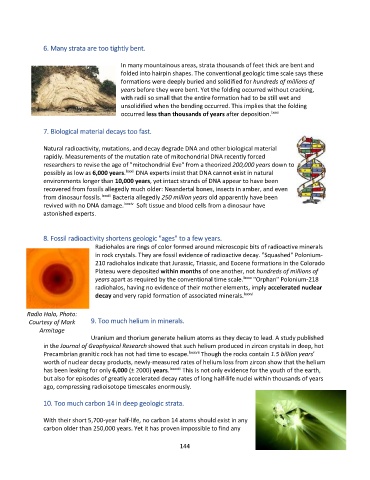Page 146 - Doctrine and History of the Preservation of the Bible revised
P. 146
6. Many strata are too tightly bent.
In many mountainous areas, strata thousands of feet thick are bent and
folded into hairpin shapes. The conventional geologic time scale says these
formations were deeply buried and solidified for hundreds of millions of
years before they were bent. Yet the folding occurred without cracking,
with radii so small that the entire formation had to be still wet and
unsolidified when the bending occurred. This implies that the folding
occurred less than thousands of years after deposition. lxxxi
7. Biological material decays too fast.
Natural radioactivity, mutations, and decay degrade DNA and other biological material
rapidly. Measurements of the mutation rate of mitochondrial DNA recently forced
researchers to revise the age of "mitochondrial Eve" from a theorized 200,000 years down to
possibly as low as 6,000 years. lxxxii DNA experts insist that DNA cannot exist in natural
environments longer than 10,000 years, yet intact strands of DNA appear to have been
recovered from fossils allegedly much older: Neandertal bones, insects in amber, and even
from dinosaur fossils. lxxxiii Bacteria allegedly 250 million years old apparently have been
revived with no DNA damage. lxxxiv Soft tissue and blood cells from a dinosaur have
astonished experts.
8. Fossil radioactivity shortens geologic "ages" to a few years.
Radiohalos are rings of color formed around microscopic bits of radioactive minerals
in rock crystals. They are fossil evidence of radioactive decay. "Squashed" Polonium-
210 radiohalos indicate that Jurassic, Triassic, and Eocene formations in the Colorado
Plateau were deposited within months of one another, not hundreds of millions of
years apart as required by the conventional time scale. lxxxv "Orphan" Polonium-218
radiohalos, having no evidence of their mother elements, imply accelerated nuclear
decay and very rapid formation of associated minerals. lxxxvi
Radio Halo, Photo:
Courtesy of Mark 9. Too much helium in minerals.
Armitage
Uranium and thorium generate helium atoms as they decay to lead. A study published
in the Journal of Geophysical Research showed that such helium produced in zircon crystals in deep, hot
Precambrian granitic rock has not had time to escape. lxxxvii Though the rocks contain 1.5 billion years’
worth of nuclear decay products, newly-measured rates of helium loss from zircon show that the helium
has been leaking for only 6,000 (± 2000) years. lxxxviii This is not only evidence for the youth of the earth,
but also for episodes of greatly accelerated decay rates of long half-life nuclei within thousands of years
ago, compressing radioisotope timescales enormously.
10. Too much carbon 14 in deep geologic strata.
With their short 5,700-year half-life, no carbon 14 atoms should exist in any
carbon older than 250,000 years. Yet it has proven impossible to find any
144

